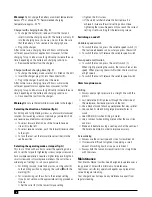
5
◆
When disposing of batteries, follow the instructions given
in the section “Protecting the environment”.
◆
Under extreme conditions, battery leakage may occur.
When you notice liquid on the battery, proceed as follows:
- Carefully wipe the liquid off using a cloth.
Avoid skin contact.
- In case of skin or eye contact, follow the instructions below.
Warning!
The battery fluid, a 25-30% solution of potassium
hydroxide, can be harmful. In case of skin contact, immediately
rinse with water. Neutralise with a mild acid such as lemon
juice or vinegar. In case of eye contact, rinse abundantly with
clean water for at least 10 minutes. Consult a physician.
Fire hazard! Avoid short-circuiting the contacts of a
detached battery (e.g. when storing the battery in a
toolbox).
Do not incinerate the battery.
Do not attempt to charge damaged batteries.
Chargers
◆
Use your Black & Decker charger only to charge batteries
of the type supplied with your tool. Other batteries could
burst, causing personal injury and damage.
◆
Never attempt to charge non-rechargeable batteries.
◆
Have defective cords replaced immediately.
◆
Do not expose to water.
◆
Do not open the charger.
◆
Do not probe the charger.
The charger is intended for indoor use only.
Electrical safety
Your charger is double insulated; therefore no earth
wire is required. Always check that the mains
voltage corresponds to the voltage on the rating
plate. Never attempt to replace the charger unit with
a regular mains plug.
Features (fig. A)
This tool includes some or all of the following features.
1. Variable speed switch or two-speed on/off switch
2. Forward/reverse slider
3. Mode selector / torque adjustment collar
4. Chuck
5. Battery
6. Battery release button
7. Charger
8. Charging base
9. Charger connector
10. Charger plug
Assembly
Fitting and removing the battery (fig. B)
◆
To fit the battery (5), line it up with the receptacle on the
tool. Slide the battery into the receptacle and push until
the battery snaps into place.
◆
To remove the battery, push the two release buttons (6)
simultaneously while at the same time pulling the battery
out of the receptacle.
Fitting and removing a drill bit or screwdriver bit
(fig. A & C)
Warning!
First remove the battery from the tool.
This tool is fitted with a keyless chuck to allow for an easy
exchange of bits.
◆
Lock the tool by setting the forward/reverse slider (2) to
the centre position (fig. A).
◆
Open the chuck by turning the front part (11) with one
hand while holding the rear part (12) with the other (fig. C).
◆
Insert the bit shank (13) into the chuck.
◆
Firmly tighten the chuck by turning the front part (11) with
one hand while holding the rear part (12) with the other.
Removing and refitting the chuck (fig. D)
◆
Open the chuck as far as possible.
◆
Remove the chuck retaining screw by turning it clockwise
using a screwdriver.
◆
Tighten an Allen key (14) into the chuck and strike it with
a hammer as shown.
◆
Remove the Allen key.
◆
Remove the chuck by turning it counterclockwise.
◆
To refit the chuck, screw it onto the spindle and secure it
with the chuck retaining screw.
Use
Charging the battery
The battery needs to be charged before first use and
whenever it fails to produce sufficient power on jobs that
were easily done before. A new battery, or a battery that has
not been used for an extended period of time, achieves full
performance only after approx. 5 charging and discharging
cycles. The battery may become warm while charging; this is
normal and does not indicate a problem.
Содержание KC 12 Series
Страница 1: ...1 UK Ireland Australia New Zealand ...
Страница 2: ...2 6 2 1 5 4 3 7 10 8 7 9 A ...
Страница 3: ...3 B C D E F G 5 6 11 13 12 14 5 8 9 10 7 15 3 ...
Страница 9: ...9 ...
Страница 10: ...10 ...






























